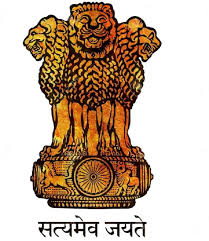State Emblem of India : Direction

The Union Home Ministry has directed states to prevent the improper depiction of the State Emblem of India, emphasizing the mandatory inclusion of the motto “Satyameva Jayate” in Devanagari script.
- Adopted as the State Emblem of India on January 26, 1950 from the Sarnath Lion Capital of Ashoka.
- Features of the State Emblem:
- Three Visible Lions: The fourth lion is hidden from view.
- Dharma Chakra: Positioned at the center of the abacus.
- Bull (Right): Represents the zodiac sign Taurus, symbolizing Buddha’s birth.
- Horse (Left): Symbolizes Kanthaka, the horse Buddha rode while renouncing princely life.
- Elephant (East): Represents Queen Maya’s dream of a white elephant entering her womb.
- Lion (North): Symbolizes Buddha’s enlightenment and Dharma propagation.
- No Bell-shaped Lotus: Omitted in the official State Emblem.
- Motto ‘Satyameva Jayate’: Taken from the Mundaka Upanishad, meaning ‘Truth Alone Triumphs’, inscribed below the emblem in Devanagari script.
- Crowned by Dharma Chakra: Represents Buddha’s first sermon (Dharmachakra Pravartana).
- Legal Provisions:
- State Emblem of India (Prohibition of Improper Use) Act, 2005: Regulates authorized use of the emblem.
- State Emblem of India (Regulation of Use) Rules, 2007: Specifies the permitted authorities and usage rules.




